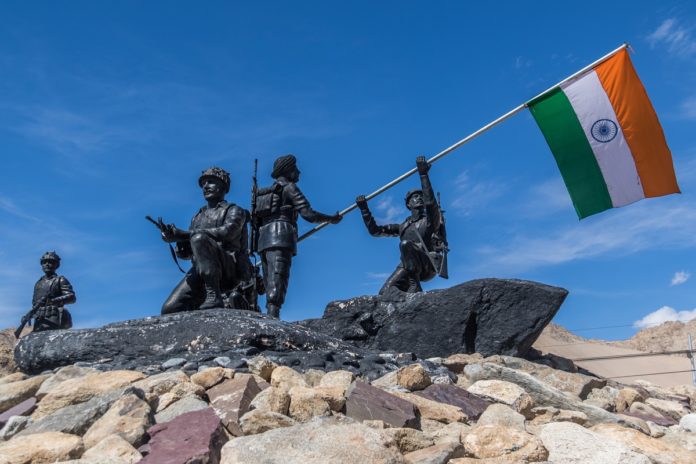
The Army on Sunday dismissed the reports that some Indian officers were confined by the Chinese Army. “There has been no confinement of Indian officers at the fringes. We completely deny this. It possibly harms national interests when news sources distribute unconfirmed news”, read the Army explanation.
In the midst of strains among India and China along the contested Line of Actual Control (LAC) there were reports that an Indian watching party was confined and later discharged by the Chines Army after an encounter broke out between the different sides in Ladakh, prior in May.
As indicated by NDTV sources, both the Indian and Chinese sides had an outskirt meeting where the officers of the different sides had a discussion and the circumstance was managed.
The occurrence occurred along the Pangong Tso lake territory.
“Forceful conduct by the different sides brought about minor wounds to troops. The different sides withdrew after exchange and communication at nearby level”, said the military explanation.
“Brief and brief span face-offs between fringe guarding troops do happen as limits are not settled. Episode of go head to head as alluded to in the article took place. Troops settle such issues commonly according to built up conventions,” the announcement read.
“The circumstance turned out to be extremely unpredictable last Wednesday when a fight between Indian jawans and the Chinese brought about detainment of a portion of our jawans however later they were discharged,” NDTV cited a senior administrator as saying.
The Army boss General Manoj Mukund Naravane had on Friday visited Leh, the central station of 14 Corps in Ladakh to survey the operational circumstance, a day after the Government on Thursday denied China’s cases that India is completing any action infringing upon the Line of Actual Control in Ladakh and Sikkim.
The People’s Liberation Army (PLA) has raised a sizeable number of tents in the Galwan Valley of the Union Territory of Ladakh – a region over which India is touchy about since the standoff in the 1962 war. In the primary seven day stretch of May, 250 Indian and Chinese warriors conflicted with iron bars, sticks, and even depended on stone-pelting in the Pangong Tso lake territory, mostly under Indian control.
Chinese interruptions occurred at three places in the Galwan area,inside Indian domain, as indicated by The Indian Express sources. Chinese soldiers have crossed the LAC at Hot Springs and in two areas 15-20 km toward the north-west, Patrolling Point 14 (PP-14) and PP-15.
India had on May 21 dismissed Beijing’s charge that Indian soldiers traversed to the Chinese side of the wilderness in Ladakh and Sikkim while asserting that it was, truth be told, the Chinese side that had as of late embraced action at the fringe impeding India’s typical watching design.
“Any recommendation that Indian soldiers had attempted action over the LAC in the Western Sector or the Sikkim area isn’t exact. Indian soldiers are completely acquainted with the arrangement of the LAC in the India-China outskirt territories and submit to it conscientiously,” External Affairs Ministry representative Anurag Srivastava had attested, including every Indian action were altogether on the Indian side of the LAC.
China has as of late blamed India for singularly endeavoring to change the status of the un-differentiated fringe in Ladakh after soldiers of the two nations were engaged with fights at Ladakh and Sikkim in which more than ten of them were harmed.
In the second seven day stretch of May, around 150 fighters of the two sides had a go head to head close Naku La Pass in Sikkim. In both the occurrences, troopers supported wounds. The two India and China have now conveyed expansion troops both in tense zones of Galwan valley, Pangong Tso lake and a few zones in northern Sikkim.
After two days, the Air Force hurried its warrior fly watches in Ladakh after Chinese military choppers were seen as flying near the Line of Actual Control (LAC).
Indian military have blamed Chinese armed force for blocking watches and superfluously raising tents and sending powers at Sikkim and Ladakh inside Indian domain on the Line of Actual Control (LAC) between the two nations.
The representative said that Indian soldiers are completely acquainted with the arrangement of the Line of Actual Control in the India-China fringe territories and keep it circumspectly.
The Indian side has consistently adopted a truly capable strategy towards fringe the executives, Srivastava said including that the legislature simultaneously, is profoundly dedicated to guaranteeing India’s power and security.
The Indian soldiers carefully follow the methods set down in different respective understandings and conventions to determine any circumstances which may emerge because of distinction in the view of the LAC.
The representative said India and China have built up systems to determine such circumstances calmly through discourse. The two sides stay drew in with one another to address any quick issues, he included.
Reviewing that Prime Minister Narendra Modi and President Xi Jinping, in their gathering at Chennai a year ago, had consented to determine such issues through exchange, the representative said Indian side remains immovably dedicated to work for the basic goal of upkeep of harmony and serenity in fringe territories. “This is a fundamental essential to the further improvement of Indian-China respective relations,” he said.
Prior this month, the Indian Army boss had expressed that transitory face-offs do happen along the LAC with China because of the varying view of the arrangement of limits.
Giving an announcement following episodes of engagements along the LAC with China, he stated, “Brief and brief span face-offs between outskirt guarding troops do happen along the LAC because of the contrasting impression of the arrangement of limits which are not settled.”
Prior, in September 2019, Indian and Chinese soldiers on the bank of the Pangong Tso Lake in eastern Ladakh engaged in a fight which was before long settled through talks between both the Armies.
Prior, the two districts were in news in June 2017 when India restricted China’s street working at Doklam Plateau that made the whole Sikkim and the “Chicken Neck” close Siliguri (associating the North-east with the territory) effectively available to the Chinese armed force.
India moved its first class strike corps close to Sikkim outskirt to counter the Chinese armed force’s war bores in Tibet. The debate finished following 73 days when Chinese People’s Liberation Army and Indian Army pulled back their soldiers from the contested site.
It is in India’s geo-political enthusiasm to shield its regional power from a potential Chinese animosity in future that its Army needs to keep up the military vigil in the region.





















